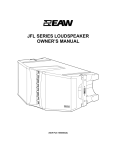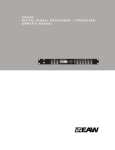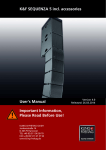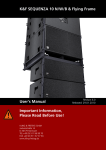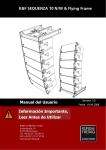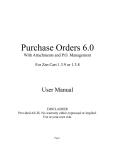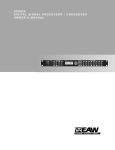Download EAW Resolution Owner`s manual
Transcript
OWNER’S MANUAL JFL213 JFL118 LOUDSPEAKERS 2 JFL213 and JFL118 Loudspeakers TABLE OF CONTENTS 1. READ THIS FIRST .................................................................................................................... 4 1.1 SAFETY PRECAUTIONS ...................................................................................................... 4 1.2 GENERAL PRECAUTIONS ................................................................................................... 4 2. INTRODUCTION....................................................................................................................... 5 3. UNPACKING ............................................................................................................................ 5 3.1 CONTENTS ........................................................................................................................... 5 4. JFL213 ARRAY DESIGN........................................................................................................... 4.1 EAW RESOLUTION.............................................................................................................. 4.1.1 Computer Requirements..................................................................................................... 4.1.2 EAW Resolution Results..................................................................................................... 4.2 GROUND STACKING ............................................................................................................ 4.3 SUBWOOFERS IN THE ARRAY ........................................................................................... 4.3.1 General Considerations ...................................................................................................... 4.3.2 JFL118 Subwoofers ............................................................................................................ 4.3.3 Suspending JFL118 Subwoofers ........................................................................................ 4.3.4 Signal Delay on Subwoofers............................................................................................... 5 5 5 6 6 6 6 6 7 7 5. ARRAY OPERATION ................................................................................................................ 5.1 OVERVIEW............................................................................................................................ 5.2 ENGINEERING DESIGN ....................................................................................................... 5.3 SYSTEM BLOCK DIAGRAM ................................................................................................. 5.4 USER ADJUSTMENTS.......................................................................................................... 5.4.1 JFL213 HF Shading – Single-Amp Mode ........................................................................... 5.4.2 JFL213 HF Shading – Bi-Amp Mode .................................................................................. 5.5 AMPLIFIER POWER REQUIREMENTS................................................................................ 5.5.1 Power Ratings .................................................................................................................... 5.6 INPUT CONNECTIONS......................................................................................................... 5.6.1 JFL213 Input Connections.................................................................................................. 5.6.1.1 Single-amp Mode.............................................................................................................. 5.6.1.2 Bi-amp Mode .................................................................................................................... 5.6.2 JFL118 Connections ........................................................................................................... 7 7 7 7 8 8 8 8 9 9 9 9 10 10 6. RIGGING & HANDLING............................................................................................................ 6.1 RIGGING OVERVIEW ........................................................................................................... 6.2 RIGGING WARNINGS ........................................................................................................... 6.3 PERMANENT INSTALLATION SUSPENSION ...................................................................... 6.3.1 PI Array Working Load Limit (WLL)..................................................................................... 6.3.2 A Note On Eyebolts ............................................................................................................ 6.3.3 Permanent Installation Overview ........................................................................................ 6.3.4 JFL213 Arrays..................................................................................................................... 6.3.5 JFL118 Arrays ..................................................................................................................... 6.3.6 Mixed JFL213 & JFL118 Arrays .......................................................................................... 6.3.7 Setting Array Tilt Angle........................................................................................................ 6.4 TRIPOD AND POLE MOUNTING .......................................................................................... 6.4.1 Tripod Mounting .................................................................................................................. 6.4.2 Pole Mounting..................................................................................................................... 10 11 11 11 11 12 12 12 13 13 13 14 14 14 7. SERVICE AND MAINTENANCE ............................................................................................... 15 7.1 GENERAL SERVICE ............................................................................................................. 15 7.2 PARTS REPLACEMENT KITS............................................................................................... 15 Owner’s Manual 3 1. READ THIS FIRST Congratulations on the purchase of your new EAW loudspeaker. You now own one of the finest professional audio products available - the result of exceptional engineering and meticulous craftsmanship. This manual is intended for use with JFL213 and JFL118 loudspeakers. As such, it contains information that is specific to these loudspeakers. This includes: array design, user adjustments, amplifier power ratings, input connections, rigging design, and service and maintenance information. An optional FB121 Fly Bar may be used to suspend JFL213 and JFL118 loudspeakers and ground stack JFL213 loudspeakers. The accompanying FB221 Rigging & Ground Stack Instructions should be consulted for information specific to its use. Finally, information common to all types of EAW loudspeakers may be found in the accompanying EAW Loudspeaker Owner’s Manual. This includes: general safety precautions, unpacking/return instructions, rigging definitions, amplifier selection best practices, signal processing , inspection and maintenance practices, as well other information common to all loudspeakers. All three manuals thus apply to the JFL213 and JFL118 loudspeakers. Please read each and follow all relevant precautions and instructions. This should allow you to obtain the maximum performance from your new loudspeaker. Where there are conflicts or overlaps, the information in this manual supersedes the information in any accompanying manual. 1.1 SAFETY PRECAUTIONS The terms “CAUTION,” “WARNING,” and “DANGER” are used throughout this manual to alert the reader to important safety considerations. If you have any questions about any aspects of these precautions, contact your local dealer, distributor, or EAW. The following are the descriptions of the safety precautions. CAUTION: describes an operating condition or user action that may expose the equipment or user to potential damage or danger. WARNING: describes an operating condition or user action that will cause damage to the equipment or injure the user. DANGER: describes an operating condition or user action that will immediately damage the equipment or be extremely dangerous or possibly life-threatening to the user. 1.2 GENERAL PRECAUTIONS WARNING: Some aspects of rigging and other related fields for which EAW manufactures, sells, or distributes equipment are potentially hazardous. Any people using this equipment are personally responsible for their own safety. EAW transactions are made with the assumption that the purchaser is a qualified individual or will have only qualified individuals perform work with the equipment. EAW will not be liable for any damages arising from the use of equipment sold to purchaser. WARNING: Only persons with the knowledge of proper hardware and safe rigging techniques should attempt to suspend JFL213 and JFL118 loudspeaker systems overhead. Failure to follow this precaution may result in damage. 4 JFL213 and JFL118 Loudspeakers 2. INTRODUCTION The JFL213 and JFL118 loudspeakers are a compact format, constant curvature line array system for venues with listener distances up to about 45 m / 148 ft. They are designed to be incredibly simple to deploy, yet provide the highest output possible from a compact line array format. The JFL213 is a 2-way full-range loudspeaker and the complementary JFL118 has a single 18 inch subwoofer. This manual provides information about the design, configuration, and operation of JFL213 and JFL118 Line Array. It is intended to be used in conjunction with the Windows®-based EAW Resolution software. Please thoroughly familiarize yourself with this manual. The JFL213 and JFL118 are physically configured for both temporary installation and permanent installation. Rigging information for these purposes may be found in this manual and the accompanying FB221 Rigging & Ground Stack Instructions. 3. UNPACKING 3.1 CONTENTS JFL213 (1) JFL213 Loudspeaker (2) QRP-JFL Quick Release Pins (1) JFL213 & JFL118 Loudspeaker Owner’s Manual (1) FB221 Rigging & Ground Stack Instructions (1) EAW Loudspeaker Owner’s Manual JFL118 (1) JFL118 Subwoofer (3) QRP-JFL Quick Release Pins (1) JFL213 & JFL118 Loudspeaker Owner’s Manual (1) FB221 Rigging & Ground Stack Instructions (1) EAW Loudspeaker Owner’s Manual 4. JFL213 ARRAY DESIGN 4.1 EAW RESOLUTION Use the EAW Resolution software for designing JFL213 arrays. It may be found in the Downloads/Software section of the EAW website: http://www.eaw.com/downloads/. EAW Resolution’s primary function is to determine the configuration that will provide the best vertical performance for a given application. Venue dimensions, the number of enclosures, array aiming angle, and Fly Bar pick point can be entered manually. Given this information, EAW Resolution provides the resultant array performance. For complete instructions about operating EAW Resolution, click on the About/Help menu when running the software. 4.1.1 Computer Requirements EAW Resolution requires a PC with Windows® XP, or Windows 7, Vista Operating System. Owner’s Manual 5 4.1.2 • • • • • • • • • 4.2 EAW Resolution Results Graphical representations of the array and the venue On-axis aiming angle for each enclosure as a difference from 0° horizontal Various angles and throw distances calculated from the venue’s dimensions Difference between the array beamwidth angle and the needed coverage angles Height of the array and trim height to the bottom of the array from the floor Pick Point on the Fly Bar to achieve the calculated array angle when suspended Weight of the array Design Factor Tolerance Calculated Frequency Response GROUND STACKING Normally, a ground-stacked JFL213 main array is used where suspension is not possible, too difficult, or too time-consuming. JFL213 – with or without JFL118 – are also quite effective when used in stage side fill or audience front fill applications. Both JFL213s and JFL118s may be ground-stacked alone or in combination. In combination, always stack JFL213s on top of JFL118s. The recommended minimum and maximum array quantities are: WARNING: Ground-stacked arrays, especially the maximum recommended arrays, may present a tipping hazard and require assembly by personnel qualified to ensure adequate stability. See the FB221 Rigging & Ground Stack Instructions for correct array assembly. Mechanical assistance may be required to lift and position enclosures for arrays taller than approx. 1.5m/5 feet. 4.3 SUBWOOFERS IN THE ARRAY 4.3.1 General Considerations Although the low frequency performance of JFL Series arrays allows them to be used without subwoofers for some events, subwoofers will normally be used for live musical performances. The recommended subwoofer is EAW’s JFL118, specifically designed to complement JFL213 & JFL210 line arrays. NOTE: Bass performance is often highly program - or venue - dependent, as well as subjective as to quantity and quality. For this reason the type, quantity, and disposition of subwoofers may vary considerably with the application. The quantity recommendations below are for general purposes, providing a balanced system for most music applications. Quantities may need to be adjusted up or down for specific situations. 4.3.2 JFL118 Subwoofers JFL118 subwoofers are designed to complement the JFL213 & JFL210 loudspeakers to both extend the low frequency response and provide more output for the upper low frequencies. JFL118 subwoofers may either be ground stacked, flown as part of a JFL213 & JFL210 array, or flown separately alongside a JFL213 & JFL210 array. A general recommendation is to use JFL213 or JFL210s and JFL118s in a 2:1 ratio. 6 JFL213 and JFL118 Loudspeakers 4.3.3 Suspending JFL118 Subwoofers The JFL118 enclosure rigging is designed to directly couple to an FB221 Fly Bar and JFL213 or JFL210 enclosures. As such, the JFL118 can be rigged seamlessly with JFL213 or JFL210s. See the FB221 Rigging & Ground Stack Instructions for more detailed information on rigging a JFL118. The JFL118s should be the uppermost enclosures when flown as part of a JFL213 or JFL210 array. In this application, the JFL118s are suspended flat-fronted, with the JFL213 or JFL210s suspended below in a constant curvature array. When flown separately, JFL118s should be flown so that the spacing between the line of JFL118 enclosures and JFL213 or JFL210 enclosures is less than 1 m / 3.3 ft. 4.3.4 Signal Delay on Subwoofers If JFL118s are flown or stacked with JFL213 or JFL210s as configured in EAW Resolution, use the factory signal delay settings. For other configurations or subwoofers, it will usually be necessary to determine the signal delay settings by measurement. 5. ARRAY OPERATION 5.1 OVERVIEW The operation of a JFL Series system involves: 1. Understanding the principles on which it operates. 2. Knowing how to electronically configure it for a specific task. 5.2 ENGINEERING DESIGN EAW Resolution software uses the fixed splay angle of the enclosure and the desired coverage pattern to determine the quantity of enclosures in the array that will optimize coverage for the audience distances and angles within the venue. The basic principle to remember is that more enclosures provide greater vertical coverage and fewer enclosures provide less vertical coverage. 5.3 SYSTEM BLOCK DIAGRAM The JFL118 powering mode is single-amp only. The JFL213 has two powering modes: single-amp and bi-amp. A JFL213 operated in single-amp mode only requires a high pass filter for low frequency excursion protection. This may be implemented in a DSP (Digital Signal Processor), equalizer, or amplifier with integrated high pass filter. The recommended filter is 60 Hz, 12dB Butterworth. An EAW UX8800 or UX3600 Processor is required to operate the JFL213 in bi-amp mode or to operate a JFL213 optimally in single-amp mode. A UX processor will operate a JFL213 in bi-amp mode with a JFL118 subwoofer. A DSP with two outputs is required to operate the JFL213 in single-amp mode with a JFL118 subwoofer. Owner’s Manual 7 The block diagrams above show the possible signal flows for a single JFL213 with JFL118. Use the same processor outputs for additional JFL213s and JFL118s on the same mix bus, i.e. “Left”, “Right”, or “Fill”. 5.4 USER ADJUSTMENTS 5.4.1 JFL213 HF Shading – Single-Amp Mode The JFL213 has a switchable HF character while in single-amp mode, controlled by the three position toggle labeled “HF Shading.” Each of the three positions is suitable for different scenarios. Be sure to select the HF shading character most appropriate for the application when using the JFL213 in single-amp mode, even when used with a UX processor: • Single Box — This switch position provides an HF character that is suitable for use with a single JFL213 that is not used in an array. • Multi Box — This switch position provides an HF character that is suitable for use with multiple JFL213s in an array in short to medium throw applications (approximately 1 m-20 m / 3 ft-66 ft). • Long Throw — This switch position provides an HF character that is suitable for use with multiple JFL213s in an array in long throw applications (approx. 20-30 m / 66 ft-98 ft). Using this switch position maintains tonal balance at long distances by adding compensation to those frequencies that suffer attenuation due to air loss. In an array where some JFL213s are being used for short to medium distances and some are used for long distances, it is appropriate to mix Long Throw and Multi Box settings as needed. 5.4.2 JFL213 HF Shading – Bi-Amp Mode The single-amp HF shading toggle switch described in the preceding section is disabled when the JFL213 is operated in bi-amp powering mode. HF shading functions are instead replicated in preprogrammed greybox settings for the UX8800 and UX3600 available on the EAW website. 5.5 AMPLIFIER POWER REQUIREMENTS The performance of the JFL213 and JFL118 depends on amplifiers delivering an adequate supply of clean power, as is true of all professional loudspeaker systems. For information on selecting amplifiers, please consult the accompanying EAW Loudspeaker Owner’s Manual. 8 JFL213 and JFL118 Loudspeakers 5.5.1 Power Ratings The JFL213 requires one full range amplifier channel when operated in single-amp mode and two amplifier channels – low frequency and high frequency – when operated in bi-amp mode. The JFL118 requires only one amplifier channel. The table below lists the rms voltage limits for the JFL213 and JFL118. Because of their higher impedance design, up to two JFL213s or multiple JFL118s can be powered from single amplifier channels. NOTE: The rms Voltage Limit listed for each sub-system (Full Range, LF, HF, and SUB) is the same for any enclosure quantity. The wattages are calculated using the Voltage Limits and the overall nominal impedance for the each listed quantity of JFL213 and JFL118 loudspeakers. CAUTION: The rms voltage limits listed above are related to the thermal limits determined from EAW’s standard power test. In this test, transducers are “exercised” to a point of damage or failure. The test signal has a 6 dB crest factor (peak to average ratio). A maximum continuous voltage limit for the loudspeaker is then determined based on the test results and on the transducer’s application in the loudspeaker. The powers listed in the table are calculated as the square of the rms voltage limit divided by the sub-system’s nominal impedance (Z) in ohms. 5.6 INPUT CONNECTIONS JFL213 and JFL118 loudspeakers utilize Neutrik® Speakon® STX Series connectors. The STX Series’ all-metal housings are extremely rugged, and feature a built-in gasket providing weather protection to IP54. Note that only the NLT4FX in-line cable connector will provide rated protection against the elements. 5.6.1 JFL213 Input Connections There are two Neutrik NLT4MP connectors on the rear of each JFL213. These connectors mate with Neutrik NLT4FX, NL4FC, and all other NL4-compatible in-line cable connectors. The following subsections describe the electrical connections for each operating mode. 5.6.1.1 Single-amp Mode JFL213 INPUT NL4 x2; see right hand Figure. NL4 #1: NL4 #2: Use as the input to the JFL213. Use the second connector to loop the full range signal to the next JFL213. Note that an additional signal can be carried on pins 2 +/- without affecting the JFL213’s operation. Owner’s Manual 9 5.6.1.2 Bi-amp Mode JFL213 INPUT NL4 x2; see right hand Figure. NL4 #1: Use as the input to the JFL213. NL4 #2: Use the second connector to loop the LF and HF signals to the next JFL213. 5.6.2 JFL118 Connections There are three Neutrik NLT4MP connectors on the rear of each JFL118 – see Figure below. Two are used for sub and high-passed signal input, while the third is used as an output to loop the high-passed signal to JFL213, JFL210 or other loudspeakers. These connectors mate with Neutrik NLT4FX, NL4FC, and all other NL4-compatible in-line cable connectors. SUB INPUT PANEL NL4 x2 NL4 #1: NL4 #2: Use as input to the JFL118. Use the second connector to loop the subwoofer signal applied to Pins 1 +/- to a subsequent JFL118. Note that a high-passed signal carried on pins 2 +/- of the input connectors is looped to pins 1 +/- of the output connector without affecting the operation of the JFL118. SUB OUTPUT PANEL NL4 x1 NL4 #3: Use as a loop-through, high-passed connection to JFL213, JFL210 or other loudspeakers. 6. RIGGING & HANDLING JFL Series arrays may be suspended via M10 mounting points or the accessory FB221 Fly Bar, ground-stacked, tripod-mounted, or pole-mounted. This manual will cover suspension using M10 mounting points and tripod / pole mounting applications. Suspension using the FB221 Fly Bar and ground-stacking applications are detailed in the accompanying FB221 Rigging & Ground Stack Instructions. Both documents recommend rigging and handling methods for most situations. Specific situations may require other methods. It is the user’s responsibility to determine the viability and safety for alternate methods and to implement them accordingly. 10 JFL213 and JFL118 Loudspeakers 6.1 RIGGING OVERVIEW The JFL213 & JFL210 full range loudspeakers each have one Rigging Tube on each enclosure side – two in total. The JFL118 subwoofer has one Rigging Tube on each enclosure side and one Rigging Tube on enclosure rear – three in total. Each Tube contains a captive Latch which slides down and attaches to the Rigging Tubes of an adjacent enclosure via a 46 mm/1.8 in Quick Release Pin–see Figure to the right. DANGER: Ensure each Quick Release Pin used in assembling an array is fully inserted and engaged into the Tube and Bar holes. Only use the supplied Quick Release Pins or equal. Pins of different lengths, diameter, or material will compromise the structural integrity of the rigging system and may result in damage to the equipment, injury, or death. Each product also includes M10 threaded Permanent Installation (PI) suspension points on enclosure top and bottom – two each for JFL213 & JFL210 and three each for JFL118. The Figure to the left illustrates their locations in the JFL213 & JFL210 top panel. M10 forged shoulder eyebolts or similar load-rated hardware may be used in these points when deploying JFL Series products in permanent installation applications. 6.2 RIGGING WARNINGS WARNING: Suspending anything, especially overhead of people, should be done with extreme caution. Always engage the services of a certified professional who is qualified to determine and implement the requirements for overhead rigging. Only persons with the knowledge of proper hardware and safe rigging techniques should attempt to suspend JFL213 or JFL210 Series arrays overhead. Failure to follow these precautions may result in damage to the equipment, injury, or death. DANGER: When suspending or stacking JFL213 or JFL210s and JFL118s, avoid placing any parts of the body between the enclosures or between an enclosure and the Fly Bar. Always use the integral handles to lift or position enclosures. Failure to follow this precaution may result in damage to the equipment, injury, or death. CAUTION: A JFL213 weighs approximately 28 kg / 62 lb. This, along with the physical size, means that one person may be able to lift and carry it. However, always use proper lifting techniques to avoid injury. Use good judgment to determine if you need lifting assistance such as another person, a back support belt, or mechanical assistance. Because it weighs approximately 44.5 kg / 98 lb, always use two people or mechanical assistance to lift a JFL118. Please see Section 4 “Rigging / Mounting / Suspension” and Section 5 “Rigging Design” in the accompanying EAW Loudspeaker Owner’s Manual for additional, important rigging information. 6.3 PERMANENT INSTALLATION SUSPENSION 6.3.1 PI Array Working Load Limit (WLL) WARNING: When the M10 threaded Permanent Installation (PI) suspension points are used the array Working Load Limit (WLL), Total Vertical Pull, is limited to five (5) any combination JFL213 or JFL118 Loudspeakers. The WLL Design Factor is 10:1. WEIGHTS: JFL213 Loudspeaker: 28 kg / 62 lb; JFL118 Loudspeaker: 44 kg/ 98 lb. Owner’s Manual 11 6.3.2 A Note On Eyebolts Load-rated eyebolts are commonly used with threaded suspension points. Eyebolts used with JFL213 and JFL118 loudspeakers must posses the following attributes: • • • • Type: Thread Size: Shank Length: WLL: Shoulder pattern M10 x 1.5 Minimum 35 mm Minimum 740 kg / 1628 lb CAUTION: Eyebolt Working Load Limits are significantly de-rated when angular lifts are applied. If an application requires an angular lift greater than 45 degrees a swivel hoist ring or similar fitting must be used – see above Figure for an example. These fittings have full swivel and pivot action, which helps avoids side loads. 6.3.3 Permanent Installation Overview The JFL213, JFL210 and JFL118 enclosures may be suspended in a permanent installation without the accessory FB221 Fly Bar. In these applications user-supplied M10 x 1.5 x 35 mm forged shoulder eyebolts or load-rated equivalent are installed in an array’s top and bottom enclosures. The top eyebolts are used for primary suspension and to set the array trim height, while the bottom eyebolts are used as pullback points to set the array tilt angle. The following instructions pertain specifically to eyebolt installation and array handling when using said eyebolts. Join enclosures within an array by following the procedures described in the accompanying FB221 Rigging & Ground Stack Instructions. 6.3.4 JFL213 Arrays a. Using a 6 mm Allen wrench, remove the two (2) flat head screws from the top panel of the uppermost array enclosure. These screws are im mediately adjacent to the side Rigging Tubes – see Figure to right. b. Thread two (2) user-supplied M10 x 1.5 x 38 mm forged shoulder eyebolts through the exposed mounting points, making sure the eye bolt shoulders are firmly seated against the enclosure. Orient each eyebolt so that the load will be applied within the plane of the eye. c. Attach the hoist mechanism and cables to the eye bolts with user-supplied Screw Pin Anchor Shackles. Minimum allowable Shackle size is 0.75 T, 9 mm / 0.31 in. d. Hoist the array until the bottom array enclosure is at comfortable working height. e. Using a 6 mm Allen wrench, remove the two (2) flat head screws from the bottom panel of the lowest array enclosure. f. Thread two (2) user-supplied M10 x 1.5 x 38 mm forged shoulder eyebolts through the exposed mounting points, again making sure the eyebolt shoulders are firmly seated against the enclosure. Orient each eyebolt so that the load will be applied within the plane of the eye. g. Attach the pull back mechanism and cables to the eyebolts with user-supplied Screw Pin Anchor Shackles. Minimum allowable Shackle size is 0.75 T, 9 mm / 0.31 in. h. Choose a target array tilt angle as guided by EAW Resolution. Hoist the array to its desired trim height using the front point. Once trim is achieved, use the rear point to set the array tilt angle. See Section 6.3.7 “Setting Array Tilt Angle” below for guidance. 12 JFL213 and JFL118 Loudspeakers 6.3.5 JFL118 Arrays a. Using a 6mm Allen wrench, remove two (2) flat head screws from the top panel of the uppermost array enclosure. These screws are immediately adjacent to the side Rigging Tubes – see Figure to the right. Do not re move the screw adjacent to the single rear Rigging Tube. b. Thread two (2) user-supplied M10 x 1.5 x 38 mm forged shoulder eyebolts through the exposed mounting points, making sure the eyebolt shoulders are firmly seated against the enclosure. Orient each eyebolt so that the load will be applied within the plane of the eye. c. Attach the hoist mechanism and cables to the eyebolts with user-supplied Screw Pin Anchor Shackles. Minimum allowable Shackle size is 0.75 T, 9 mm / 0.31 in. d. Hoist the array such that the bottom array enclosure is set to a comfortable working height. e. Using a 6mm Allen wrench, remove the flat head screw adjacent to the single rear Rigging Tube from the bottom panel of the lowest array enclosure – see Figure to right. f. Thread one (1) user-supplied M10 x 1.5 x 38 mm forged shoulder eyebolt through the ex posed mounting point, again making sure the eyebolt shoulder is firmly seated against the enclosure. Orient the eyebolt so that the load will be applied within the plane of the eye. g. Attach the pull back mechanism and cable to the eyebolt with a user-supplied Screw Pin Anchor Shackle. Minimum allowable Shackle size is 0.75 T, 9 mm / 0.31 in. h. Choose a target array tilt angle as guided by EAW Resolution. Hoist the array to its desired trim height using the front point. Once trim is achieved, use the rear point to set the array tilt angle. See Section 6.3.7 “Setting Array Tilt Angle” below for guidance. 6.3.6 Mixed JFL213 & JFL118 Arrays Combinations of JFL213 and JFL118 Loudspeakers may be suspended in the same array. When doing so JFL118s are always suspended above JFL213s. a. b. c. d. Follow Steps a through d in Section 6.3.5 to first suspend JFL118 loudspeakers. Join JFL213 loudspeakers to suspended JFL118 loudspeakers. Follow Steps e through g in Section 6.3.4 to attach the array pull back mechanism. Choose a target array tilt angle as guided by EAW Resolution. Hoist the array to its desired trim height using the front point. Once trim is achieved, use the rear point to set the array tilt angle. See Section 6.3.7 “Setting Array Tilt Angle” below for guidance. 6.3.7 Setting Array Tilt Angle Normally the easiest method to determine array tilt angle is to use a clinometer such as the simple, bubble-type angle finder, similar to that shown here. More fancy, albeit more expensive, electronic clinometers can also be used. Place the angle finder against the grille of the uppermost array enclosure that can be physically reached. Adjust the angle of the entire array so that the face of this enclosure is set at its prescribed aiming angle given in the EAW Resolution. Owner’s Manual 13 6.4 TRIPOD AND POLE MOUNTING 6.4.1 Tripod Mounting The JFL213 may be mounted on a tripod loudspeaker stand with a 35 mm / 1.38 in diameter pole. The tripod loudspeaker stand must be rated to support minimum 60 kg / 132 lb. The JFL213’s integral pole-mount holes allow 0° and -15° aiming by choosing the hole specified in Figure below. A maximum of two (2) JFL213 loudspeakers may be mounted on a tripod stand. CAUTION: All enclosures must be securely pinned together. To do so follow the procedures described in the accompanying FB221 Rigging & Ground Stack Instructions. 6.4.2 Pole Mounting Up to two (2) JFL118 subwoofers may be used as a base for up to two (2) pole-mounted JFL213s. In this configuration a 35 mm / 1.38 in diameter loudspeaker pole is inserted between the JFL118’s pole cup and either of the JFL213’s integral pole mount holes. The latter holes allow the JFL213 to be aimed at 0° or -15° as described in Section 6.4.1 Tripod Mounting. The pole may be a fixed length or height adjustable. In either case it must be rated to support minimum 60 kg / 132 lb. EAW’s model SPM100 height-adjustable pole is an ideal companion – see right hand Figure. A primary Quick Release Pin and secondary clamp mechanism is used to set JFL213 height. To use: a. b. c. d. Stack up to two (2) JFL118 loudspeakers on a level, stable surface. Insert the SPM100 pole in the uppermost JFL118’s pole mount cup. Remove the pole’s Quick Release Pin from its stored position and loosen the clamp handle. Raise the inner pole to the desired height and insert the Quick Release pin in the nearest through-hole. e. Lower the inner pole so that the pin is resting atop the clamp mechanism. f. Tighten the clamp handle so that the inner pole cannot easily rotate. Do not over-tighten; the Quick Release Pin should bear the weight of the JFL213(s). g. Stack up to two (2) JFL213 loudspeakers on the SPM100 pole. CAUTION: All enclosures must be securely pinned together. To do so follow the procedures described in the accompanying FB221 Rigging & Ground Stack Instructions. 14 JFL213 and JFL118 Loudspeakers 7. SERVICE AND MAINTENANCE 7.1 GENERAL SERVICE Please refer to Section 11 “Inspection and Maintenance” and Section 12 “Troubleshooting” in the accompanying EAW Loudspeaker Owner’s Manual for general Service, Maintenance, and Troubleshooting instructions. 7.2 PARTS REPLACEMENT KITS In the event a JFL Series loudspeaker requires field service, a number of Parts Replacement Kits are available through the EAW Service Department. These include but are not limited to: • • • • • • • • LF Woofer HF Diaphragm Left & Right Rigging Assemblies Quick Release Pin w/ Lanyard Input Panel Assembly Passive Crossovers Grilles HF Horn Please see the JFL213 Loudspeaker Replacement Kit Instructions, available on the EAW website’s JFL product pages, for further information. Owner’s Manual 15 If you have questions about this JFL213 & JFL118 Loudspeaker Owner’s Manual please contact the EAW Application Support Group: One Main Street, Whitinsville, MA 01588 2040472 (A) April 2013 tel: 800 992 5013 / 508 234 6158 fax: 508 234 8251 web: www.eaw.com e-mail: [email protected] EAW is the worldwide technological and market leader in the design and manufacture of high-performance professional loudspeaker systems.
















